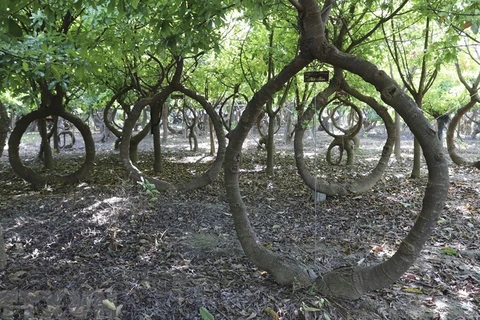Ninh Thuan (VNS/VNA) - The south-central province of Ninh Thuan is growing coastal forests to minimise the effects of natural disasters while also increasing green cover.
Le Huyen, deputy chairman of the provincial People’s Committee, said the plan also seeks to preserve coastal bio-diversity, prevent desertification and soil degradation and adapt to climate change and sea-level rise.
The province, the country’s driest, is strengthening the management of forests in its coastal areas.
It will allot around 6,500ha of protective and special-use forests for individuals, companies and others to protect and exploit by 2030.
By then it plans to plant 200ha of protective forests in sand dunes and rocky mountains along the coast, develop aquaculture models on 1,500ha of the forests, mostly mangrove.
It will plant more trees in 420ha of existing protective forests that have a low density of vegetation.
It will develop livelihood models like breeding aquatic species in mangrove forests to improve participating households’ incomes.
It is using advanced techniques to grow protective forests and tend them since it has prolonged dry weather and poor soil.
It has chosen indigenous forest trees that can adapt to dry weather and are not foraged by animals since the province has a large number of livestock like goats and sheep and farmers normally let them graze in forests.
One of the indigenous trees is thanh that (Ailanthus triphysa), an evergreen tree also called white bean and ferntop ash, which can grow 20 metres tall on rocky mountains and are not destroyed by domestic animals.
In 2015 the Thuan Nam District Protective Forest Management Board planted the trees on a trial basis on an area of 5ha on rocky mountains and they grew well, and it then planted them on more than 650ha.
Many of them have now grown 2.5-3 metres tall.
The province has more than 196,800ha of forest lands, 125,969ha meant for protective forests, 41,600ha for special-use forests and the rest for growing commercial trees.
It planted 547ha of new forests last year.
It has allotted more than 66,500ha to private entities to protect and exploit, helping improve forest quality.
The province has a 47 percent forest cover./.
Le Huyen, deputy chairman of the provincial People’s Committee, said the plan also seeks to preserve coastal bio-diversity, prevent desertification and soil degradation and adapt to climate change and sea-level rise.
The province, the country’s driest, is strengthening the management of forests in its coastal areas.
It will allot around 6,500ha of protective and special-use forests for individuals, companies and others to protect and exploit by 2030.
By then it plans to plant 200ha of protective forests in sand dunes and rocky mountains along the coast, develop aquaculture models on 1,500ha of the forests, mostly mangrove.
It will plant more trees in 420ha of existing protective forests that have a low density of vegetation.
It will develop livelihood models like breeding aquatic species in mangrove forests to improve participating households’ incomes.
It is using advanced techniques to grow protective forests and tend them since it has prolonged dry weather and poor soil.
It has chosen indigenous forest trees that can adapt to dry weather and are not foraged by animals since the province has a large number of livestock like goats and sheep and farmers normally let them graze in forests.
One of the indigenous trees is thanh that (Ailanthus triphysa), an evergreen tree also called white bean and ferntop ash, which can grow 20 metres tall on rocky mountains and are not destroyed by domestic animals.
In 2015 the Thuan Nam District Protective Forest Management Board planted the trees on a trial basis on an area of 5ha on rocky mountains and they grew well, and it then planted them on more than 650ha.
Many of them have now grown 2.5-3 metres tall.
The province has more than 196,800ha of forest lands, 125,969ha meant for protective forests, 41,600ha for special-use forests and the rest for growing commercial trees.
It planted 547ha of new forests last year.
It has allotted more than 66,500ha to private entities to protect and exploit, helping improve forest quality.
The province has a 47 percent forest cover./.
VNA
























